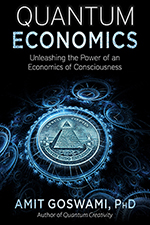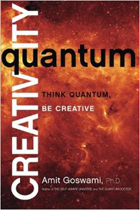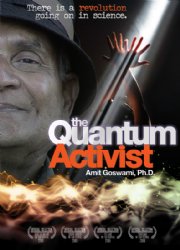Roughly one-half of people in developed and developing countries today believes that everything is made of matter; that somehow under some conditions, macromolecules of matter develop survival need, this need leads to complex structures of life via evolution with help from random changes in the hereditary material we have from which nature selects our evolution. The pursuit of survival needs has given us a human condition characterized by:
- Me-centeredness
- Tendencies for seeking pleasure and reward
- Tendency for information processing
- Five times more negative emotional tendencies than positive
Materialists see nothing wrong with human nature being this way; it is what it is. If we keep on creating better and better technology and create enough prosperity to satisfy people’s me-centered need of good car, good food, good house, and good spouse (in the USA, they call it the American dream), if we develop newer and newer ways to provide people with pleasure and entertainment, if we keep people busy with information processing with social media and new generations of cell phones and lap tops, everyone will be happy. Oh yes; there is that pesky little problem of the brain built more negative than positive. But we can handle that with positive psychology, teaching people how to give positive spin to their experiences and some pretend virtuous behaviour. True, the virtuous values are not real, they are not needed for survival; but pretending them in human interactions helps maintain social cohesion and civilization.
The other half of humanity in these nations believes in a God-matter dualism; in this view, a nonmaterial God created humans in His own image by embodying virtues in the human brain, virtues such as love and goodness. People should live these virtues or else they invite God’s wrath.
Religions have always said that living only survival needs are an invitation to the evil; excessive pursuit of them is sin—moving away from God. In this way, the pursuit of higher needs—the virtues—is what moves us toward God. And that is the purpose of life.
Religion is older of the two worldviews. Indeed, even today, there are a substantial number of people who try to follow these religious virtues—goodness, love, fairness, truth, etc. Some even succeed and seem to be happier.
The flip side is that a large number of religious people, even teachers, fall prey to the base-level human condition built into everyone and get caught.
There is a flip side also for scientific materialism. The current decline of civilization is clear; it could not be a coincidence that the decline started in the nineteen eighties when scientific materialism took hold of science and the takeover continues with no end in sight. A study of history shows also undeniably that overall human beings have experienced steadily increasing civilization at least on the average, during the period of eighteenth through twentieth century when science ruled matter and produced technology and kept a check on religious monopoly on everything but overall religions ruled the minds of people and kept people pursuing a modicum of virtues.
Metaphysically, scientific materialism is a monism—material monism—and is better than the dualism of religion whose metaphysical problem is to explain how does God—a being of virtuous ideas—interact with matter, which is concrete, not idea? How do we, made of matter, embody God’s virtues without any interaction with Him?
It gets supremely interesting when we realize that even materialists agree that today the most important outstanding problem to solve is consciousness, undeniably a fundamental aspect of the human being. What is consciousness? How we think of consciousness will determine what theories we entertain about it, what aspects of it we believe and try to verify. If we think everything is matter, we have a problem to begin with: inanimate nonliving matter does not seem to be conscious, at least not conscious like us. Even living matter of early evolution—bacteria and plants—have more in common with inert matter than us human beings as far as consciousness is concerned. Therefore, in everything-is-matter philosophy consciousness has to be an emergent property of complexity—complex conglomerates of matter such as our brains.
At first sight, this emergentist approach may seem reasonable to you. After all, you know that when two gases hydrogen and oxygen combine together and make water, new properties of water do emerge. However, you are missing something peculiar about consciousness.
Think. Matter comprises what we call objects of our experience. Experience has another pole—the experiencer or subject; that is, you, or what you call your “I.” “I (subject) see a flower (object).” In this way, materialists are missing something about consciousness via its adherence to everything is matter—objects—philosophy; the subjective aspect of our experience of consciousness.
Not so fast, though. One problem is that you can also look at your “I” and make it into an object; you call it me. Is the “I” real or is it all “me?” Materialists say that I is all me except for a little individuality, the I or me-experience has an individual subjective quality to it (called quale) that cannot be explained away. However, the emergence of a subjective quale from a complex aggregate of matter may be possible to demonstrate, claims the optimists of emergentism.
It is undoubtedly true that our brain is associated with our experience of consciousness. Brain comprises a neural network. How can a neural network be conscious, can cognize?
In the nineteen fifties, modern computer technology came about along with it the concept of artificial intelligence. There was much give and take between modelists of artificial intelligence and modelists of the brain.
A simple computer model of consciousness of the brain would assume a central processing unit (CPU) that controls all its other software programs of neural network. An incoming signal, for example an optical stimulus will go directly from the eye to the brain’s CPU in the cortex. But in a recent neuroscience experiment it was found that an incoming signal is first processed in other sub-organs of the brain. This kind of experiment has shaken up the field of consciousness research wide open even for materialists.
I recently read about a discussion among materialist consciousness researchers commenting about the panpsychism model of consciousness—everything in the world, living and nonliving—is conscious. This sounds like almost the complete opposite of the metaphysics of scientific materialism. Instead of everything is made of matter, panpsychism seems to be saying everything is made of consciousness as well. But of course, panpsychism is pure philosophy; there is no scientific evidence suggesting it.
So, are we machines (albeit a theory of consciousness may elude us for a while) or are we conscious to begin with? Besides panpsychism, there is another very old, quite well-known non-dual perspective for thinking about consciousness–consciousness is primary, is the ground of being—that is finding support from quantum physics. Quantum physics is the physics of possibilities, possibilities for consciousness to choose from. The choice defines the I/subject of the experience: I choose, therefore I am.
This view, albeit backed by quantum physics, the scientific materialists resist tooth and nail. Mostly, they do it by labelling it as Eastern mysticism. If you are a “Westerner” born and brought up in the West, you should get the idea. You are familiar with the East-West divide: East is East, West is West, and the twain shall never meet. This was propagated during the heyday of the British empire to justify the domination of a people with highly sophisticated notions about consciousness that challenges the developing materialist science—those notions were mystical, mysterious, and obscure ideas, not real, not to be trusted.
My work over the last thirty years shows that indeed Consciousness is the ground of all being and quantum science proves that beyond any doubt. Neuroscience data is suggesting that indeed, the brain works in two modalities: 1) a conditioned machine-like local modality involving a few brain areas and 2) a nonlocal creative modality in which many brain areas become involved in a coherent synchronized nonlocal movement. Nonlocality—signalless instant communication at a distance—is a definitive sign of quantum movement.
Excessive intellectualism, information processing and glorification of step-by-step logic has shaped an incomplete worldview that works as an explanatory principle for only the mechanical part of the human but leaves most of the human potentialities out of our reach. This has created a situation where we are disconnected from feelings and intuitions that bring us motivations for change among many other things. Let us look at the world as it is, not as it should be (mechanical) following an idea (scientific materialism).
I am talking about a worldview change. That’s the very first step. The most important step. I invite you to dig deep and feel the sense of awe in your own way when you realize what quantum science is talking about. What happens when you change your worldview for primacy of matter where you are just a robot with experience to a worldview based on primacy of consciousness where you can play a participatory role?



